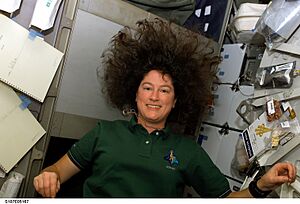Laurel Clark facts for kids
Quick facts for kids
Laurel Clark
|
|
|---|---|

Laurel Clark
|
|
| Born |
Laurel Blair Salton
March 10, 1961 Ames, Iowa, U.S.
|
| Died | February 1, 2003 (aged 41) Over Texas
|
| Awards |
|
| Space career | |
| NASA astronaut | |
|
Previous occupation
|
Flight surgeon |
| Rank | Captain, U.S. Navy |
|
Time in space
|
15d 22h 20m |
| Selection | 1996 NASA Group |
| Missions | STS-107 |
|
Mission insignia
|
|
Laurel Blair Clark (born March 10, 1961 – died February 1, 2003) was a brave NASA astronaut and a medical doctor. She was also a captain in the United States Navy. Laurel Clark was a mission specialist on the Space Shuttle Columbia. Sadly, she and her six crewmates passed away during the Columbia disaster. After her death, she received the Congressional Space Medal of Honor for her service.
Contents
About Laurel Clark
Laurel Clark was born in Ames, Iowa. But she always thought of Racine, Wisconsin as her true home. She was a member of a sorority called Gamma Phi Beta while studying at the University of Wisconsin–Madison.
Laurel also had a special license for ham radio. This allowed her to talk to people using radio waves.
She was married to Dr. Jonathan Clark, who was also a former U.S. Navy captain and a NASA flight surgeon. They had a son named Iain, who was born in 1996.
Laurel's Education
Laurel Clark worked hard in school to achieve her dreams.
- 1979: She finished high school at William Horlick High School in Racine, Wisconsin.
- 1983: She earned a Bachelor of Science degree in Zoology from the University of Wisconsin–Madison. Zoology is the study of animals.
- 1987: She received her medical doctorate from the University of Wisconsin–Madison. This meant she was now a medical doctor.
Military Career
After medical school, Laurel Clark joined the United States Navy. She trained to be a doctor for divers and submariners. She even dove with Navy divers and special forces teams called Navy SEALs. She also helped people who got sick on U.S. submarines.
Later, she trained to be a Naval Flight Surgeon. This meant she was a doctor for pilots and aircrew. She worked with a Marine Corps squadron and flew on many different aircraft. Her squadron even won an award for being the best!
Before becoming an astronaut, she was a flight surgeon for a training squadron. Laurel was very qualified. She was certified by the National Board of Medical Examiners and had a medical license in Wisconsin.
Becoming a NASA Astronaut
NASA chose Laurel Clark to be an astronaut in April 1996. She moved to the Johnson Space Center in Houston, Texas. For two years, she trained very hard. She learned everything she needed to know to fly in space as a mission specialist.
From 1997 to 2000, she worked in the Astronaut Office. She helped with planning what would go into space and how astronauts would live there.
Space Flight Experience
Laurel Clark's only space mission was STS-107 aboard the Space Shuttle Columbia. The mission lasted for almost 16 days. It was a special trip focused on science and research. The crew worked day and night, doing about 80 different experiments.
Laurel's experiments included growing plants in space. She talked about this just a few days before the mission ended. The STS-107 mission ended on February 1, 2003. The Columbia broke apart as it returned to Earth. All seven astronauts, including Laurel, passed away.
Laurel even recorded videos inside the cockpit during Columbia's return. She used a small digital camera to capture the moments.
Her last message to her friends and family was an email from space. She wrote that Earth looked "magnificent" from above. She said that even though she spent a lot of time working, looking out at Earth was "glorious." She also mentioned how hard it was to take clear photos of Earth. Laurel also shared how strange it was to feel almost no thirst in space.
Awards and Honors
Laurel Clark received many awards and honors for her service.
Special Badges
- Naval Astronaut/Flight Surgeon
- Naval Flight Surgeon
- Diving Medical Officer
- Submarine Medical Officer
Important Awards
- Defense Distinguished Service Medal (awarded after her death)
- Navy and Marine Corps Commendation Medal (3 awards)
- Congressional Space Medal of Honor (awarded after her death)
- NASA Distinguished Service Medal (awarded after her death)
- NASA Space Flight Medal (awarded after her death)
- National Defense Service Medal
- Overseas Service Ribbon
Tributes and Memorials
Many things have been named in honor of Laurel Clark:
- An Asteroid called 51827 Laurelclark was named after her.
- A hill on Mars in the Columbia Hills is named Clark Hill.
- A crater on the Moon, inside the larger crater Apollo, is named L. Clark.
- Clark Hall at the Florida Institute of Technology is named after her.
- The Laurel Salton Clark Memorial Fountain in Racine, Wisconsin, honors her.
- The Naval Aerospace Medicine Institute in Pensacola named its academic center after Laurel Clark and David M. Brown.
- Clark Auditorium at Walter Reed National Military Medical Center displays some of her uniforms and personal items.
- The Scottish band Runrig paid tribute to Laurel on their 2016 album The Story. The last song ends with a recording of her voice. Laurel was a big fan of the band. She even took their 2001 CD into space with her. After the shuttle accident, the CD was found and given back to the band by her family.
See also
 In Spanish: Laurel Blair Salton Clark para niños
In Spanish: Laurel Blair Salton Clark para niños



